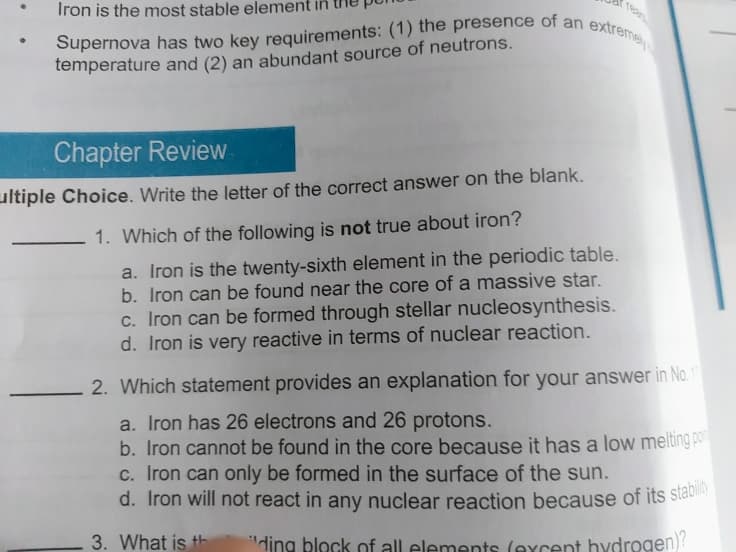1. Which of the following is not true about iron? a. Iron is the twenty-sixth element in the periodic table. b. Iron can be found near the core of a massive star. c. Iron can be formed through stellar nucleosynthesis. d. Iron is very reactive in terms of nuclear reaction.
1. Which of the following is not true about iron? a. Iron is the twenty-sixth element in the periodic table. b. Iron can be found near the core of a massive star. c. Iron can be formed through stellar nucleosynthesis. d. Iron is very reactive in terms of nuclear reaction.
Principles of Modern Chemistry
8th Edition
ISBN:9781305079113
Author:David W. Oxtoby, H. Pat Gillis, Laurie J. Butler
Publisher:David W. Oxtoby, H. Pat Gillis, Laurie J. Butler
Chapter19: Nuclear Chemistry
Section: Chapter Questions
Problem 46AP
Related questions
Question

Transcribed Image Text:rean
d. Iron will not react in any nuclear reaction because of its stabilit
Supernova has two key requirements: (1) the presence of an extreme
Iron is the most stable element in
temperature and (2) an abundant source of neutrons.
Chapter Review
ultiple Choice. Write the letter of the correct answer on the blank.
1. Which of the following is not true about iron?
a. Iron is the twenty-sixth element in the periodic table.
b. Iron can be found near the core of a massive star.
c. Iron can be formed through stellar nucleosynthesis.
d. Iron is very reactive in terms of nuclear reaction.
2. Which statement provides an explanation for your answer in No.
a. Iron has 26 electrons and 26 protons.
b. Iron cannot be found in the core because it has a low melting po
c. Iron can only be formed in the surface of the sun.
d. Iron will not react in any nuclear reaction because of its stabi
3. What is th
ding block of all elements (excent hydrogen)?
Expert Solution
This question has been solved!
Explore an expertly crafted, step-by-step solution for a thorough understanding of key concepts.
This is a popular solution!
Trending now
This is a popular solution!
Step by step
Solved in 4 steps

Knowledge Booster
Learn more about
Need a deep-dive on the concept behind this application? Look no further. Learn more about this topic, chemistry and related others by exploring similar questions and additional content below.Recommended textbooks for you

Principles of Modern Chemistry
Chemistry
ISBN:
9781305079113
Author:
David W. Oxtoby, H. Pat Gillis, Laurie J. Butler
Publisher:
Cengage Learning

Chemistry for Today: General, Organic, and Bioche…
Chemistry
ISBN:
9781305960060
Author:
Spencer L. Seager, Michael R. Slabaugh, Maren S. Hansen
Publisher:
Cengage Learning

Chemistry: Matter and Change
Chemistry
ISBN:
9780078746376
Author:
Dinah Zike, Laurel Dingrando, Nicholas Hainen, Cheryl Wistrom
Publisher:
Glencoe/McGraw-Hill School Pub Co

Principles of Modern Chemistry
Chemistry
ISBN:
9781305079113
Author:
David W. Oxtoby, H. Pat Gillis, Laurie J. Butler
Publisher:
Cengage Learning

Chemistry for Today: General, Organic, and Bioche…
Chemistry
ISBN:
9781305960060
Author:
Spencer L. Seager, Michael R. Slabaugh, Maren S. Hansen
Publisher:
Cengage Learning

Chemistry: Matter and Change
Chemistry
ISBN:
9780078746376
Author:
Dinah Zike, Laurel Dingrando, Nicholas Hainen, Cheryl Wistrom
Publisher:
Glencoe/McGraw-Hill School Pub Co

Introductory Chemistry: A Foundation
Chemistry
ISBN:
9781337399425
Author:
Steven S. Zumdahl, Donald J. DeCoste
Publisher:
Cengage Learning


Chemistry for Engineering Students
Chemistry
ISBN:
9781337398909
Author:
Lawrence S. Brown, Tom Holme
Publisher:
Cengage Learning